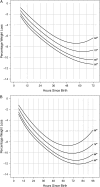Early weight loss nomograms for exclusively breastfed newborns
- PMID: 25554815
- PMCID: PMC4279066
- DOI: 10.1542/peds.2014-1532
Early weight loss nomograms for exclusively breastfed newborns
Abstract
Background: The majority of newborns are exclusively breastfed during the birth hospitalization, and weight loss is nearly universal for these neonates. The amount of weight lost varies substantially among newborns with higher amounts of weight loss increasing risk for morbidity. No hour-by-hour newborn weight loss nomogram exists to assist in early identification of those on a trajectory for adverse outcomes.
Methods: For 161 471 term, singleton neonates born at ≥36 weeks' gestation at Northern California Kaiser Permanente hospitals in 2009-2013, data were extracted from the birth hospitalization regarding delivery mode, race/ethnicity, feeding type, and weights from electronic records. Quantile regression was used to create nomograms stratified by delivery mode that estimated percentiles of weight loss as a function of time among exclusively breastfed neonates. Weights measured subsequent to any nonbreastmilk feeding were excluded.
Results: Among this sample, 108 907 newborns had weights recorded while exclusively breastfeeding with 83 433 delivered vaginally and 25 474 delivered by cesarean. Differential weight loss by delivery mode was evident 6 hours after delivery and persisted over time. Almost 5% of vaginally delivered newborns and >10% of those delivered by cesarean had lost ≥10% of their birth weight 48 hours after delivery. By 72 hours, >25% of newborns delivered by cesarean had lost ≥10% of their birth weight.
Conclusions: These newborn weight loss nomograms demonstrate percentiles for weight loss by delivery mode for those who are exclusively breastfed. The nomograms can be used for early identification of neonates on a trajectory for greater weight loss and related morbidities.
Keywords: breastfeeding; infant; lactation; newborn; weight loss.
Copyright © 2015 by the American Academy of Pediatrics.
Figures
Comment in
-
Categorizing weight loss in breastfed infants: a good first step.Pediatrics. 2015 Jan;135(1):e174-5. doi: 10.1542/peds.2014-3354. Epub 2014 Dec 1. Pediatrics. 2015. PMID: 25452657 No abstract available.
References
-
- UNICEF/WHO. Baby-Friendly Hospital Initiative: Revised, Updated and Expanded for Integrated Care, Section 1, Background and Implementation, Preliminary version 2006. Available at: http://www.who.int/nutrition/topics/BFHI_Revised_Section1.pdf. Accessed October 14, 2014 - PubMed
-
- US Department of Health and Human Services. Developing Healthy People 2020–Maternal, Infant and Child Health. 2010. Available at: http://www.healthypeople.gov/hp2020/Objectives/ViewObjective.aspx?Id=177...>. Accessed April 6, 2010
-
- American Academy of PediatricsSection on Breastfeeding . Breastfeeding and the use of human milk. Pediatrics. 2012;129(3). Available at: www.pediatrics.org/cgi/content/full/129/3/e827 - PubMed
-
- Centers for Disease Control and Prevention. Maternal, infant and child health. Data 2020. 2013. Available at: http://www.healthypeople.gov/2020/topics-objectives/topic/maternal-infan.... Accessed March 20, 2014
-
- Slusher TM, Slusher IL, Keating EM, et al. Comparison of maternal milk (breastmilk) expression methods in an African nursery. Breastfeed Med. 2012;7(2):107–111 - PubMed
Publication types
MeSH terms
Grants and funding
LinkOut - more resources
Full Text Sources
Other Literature Sources
Medical



